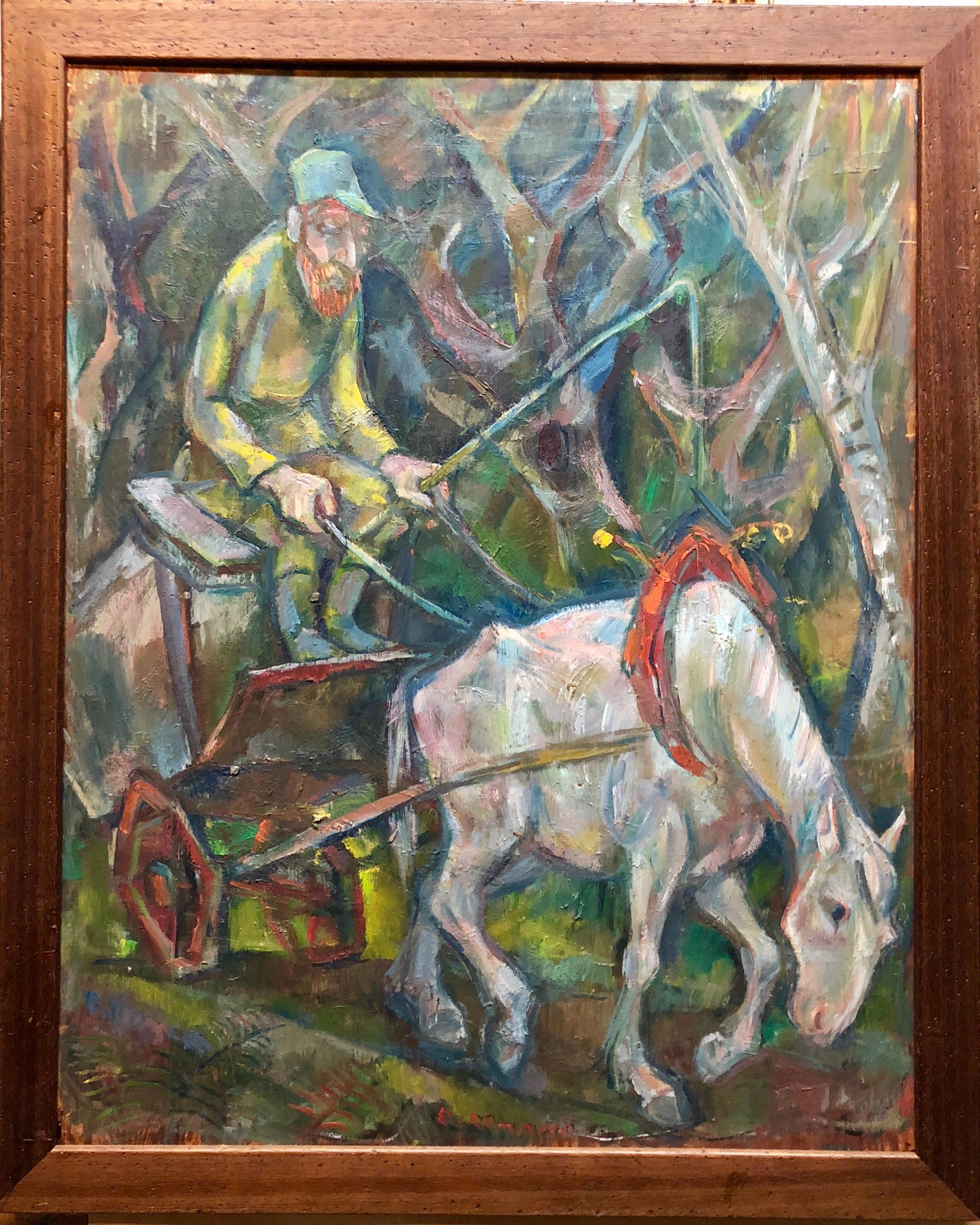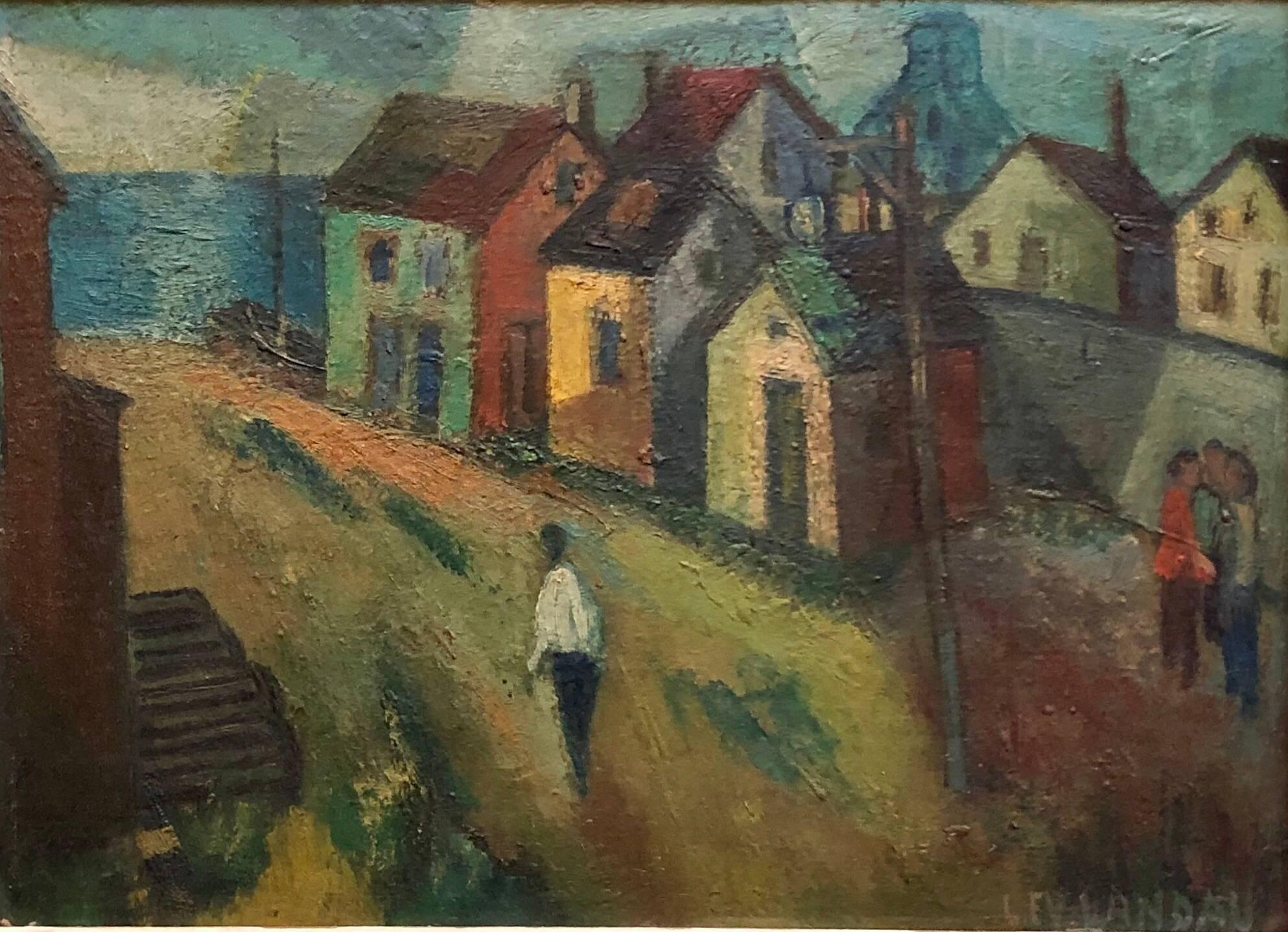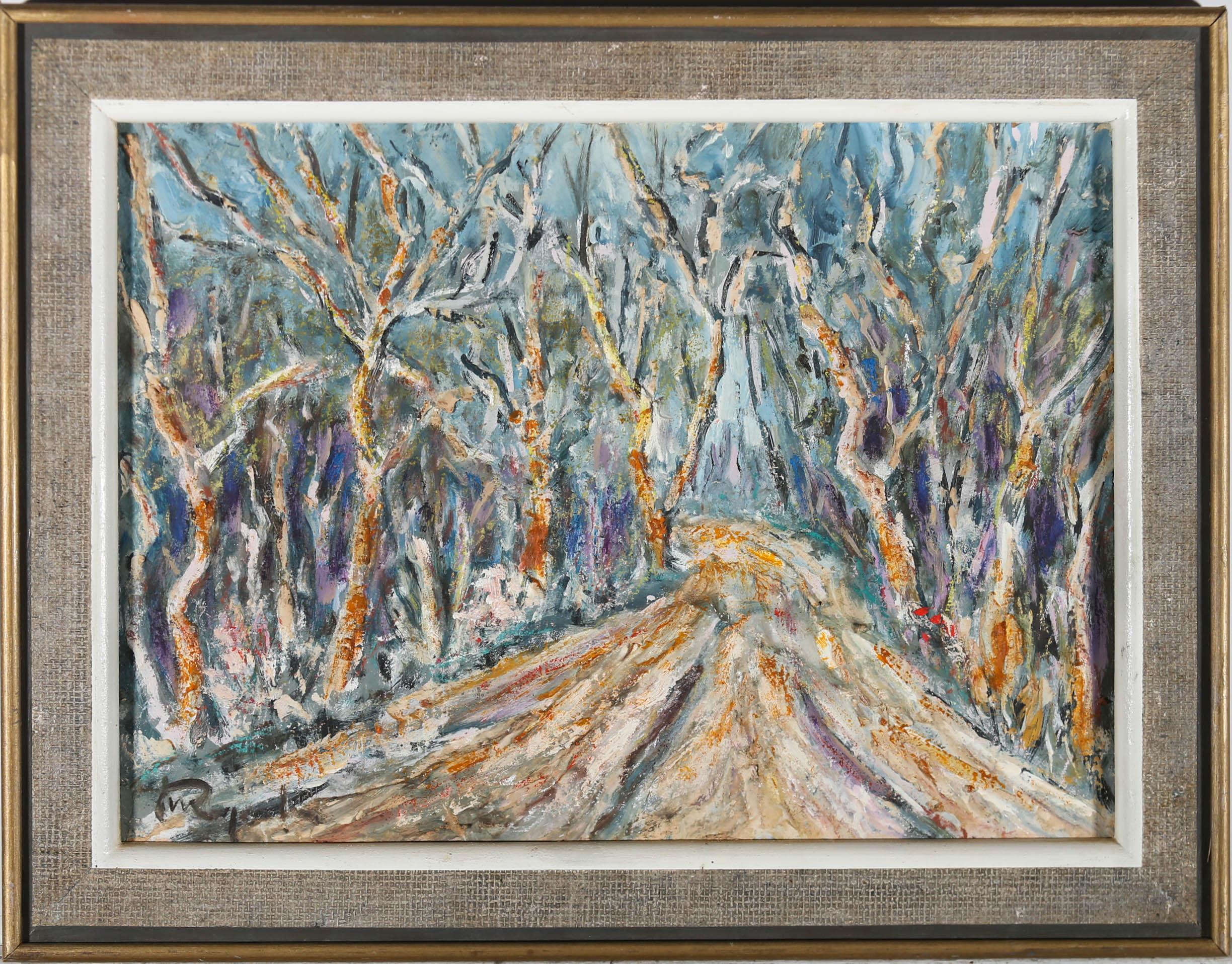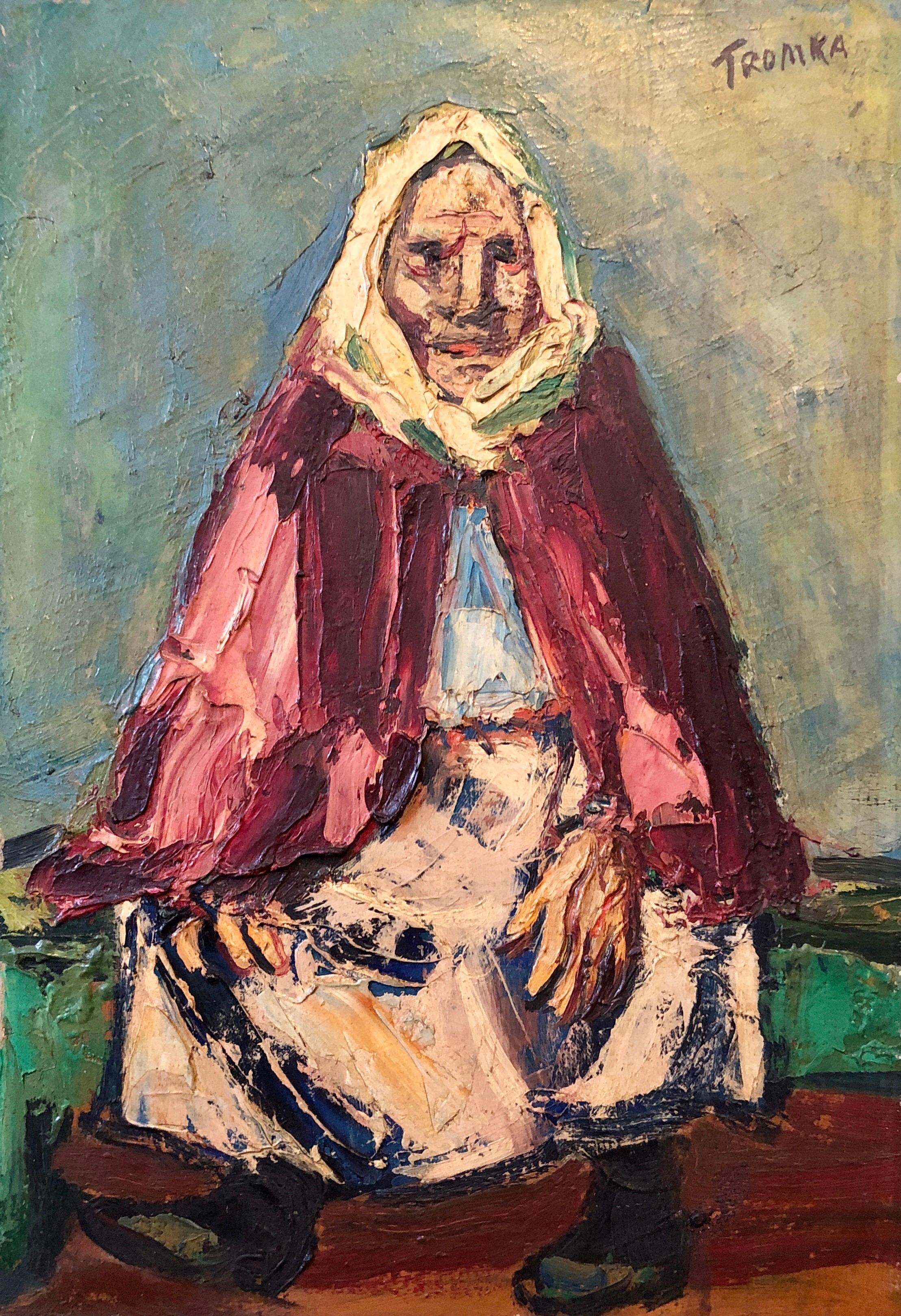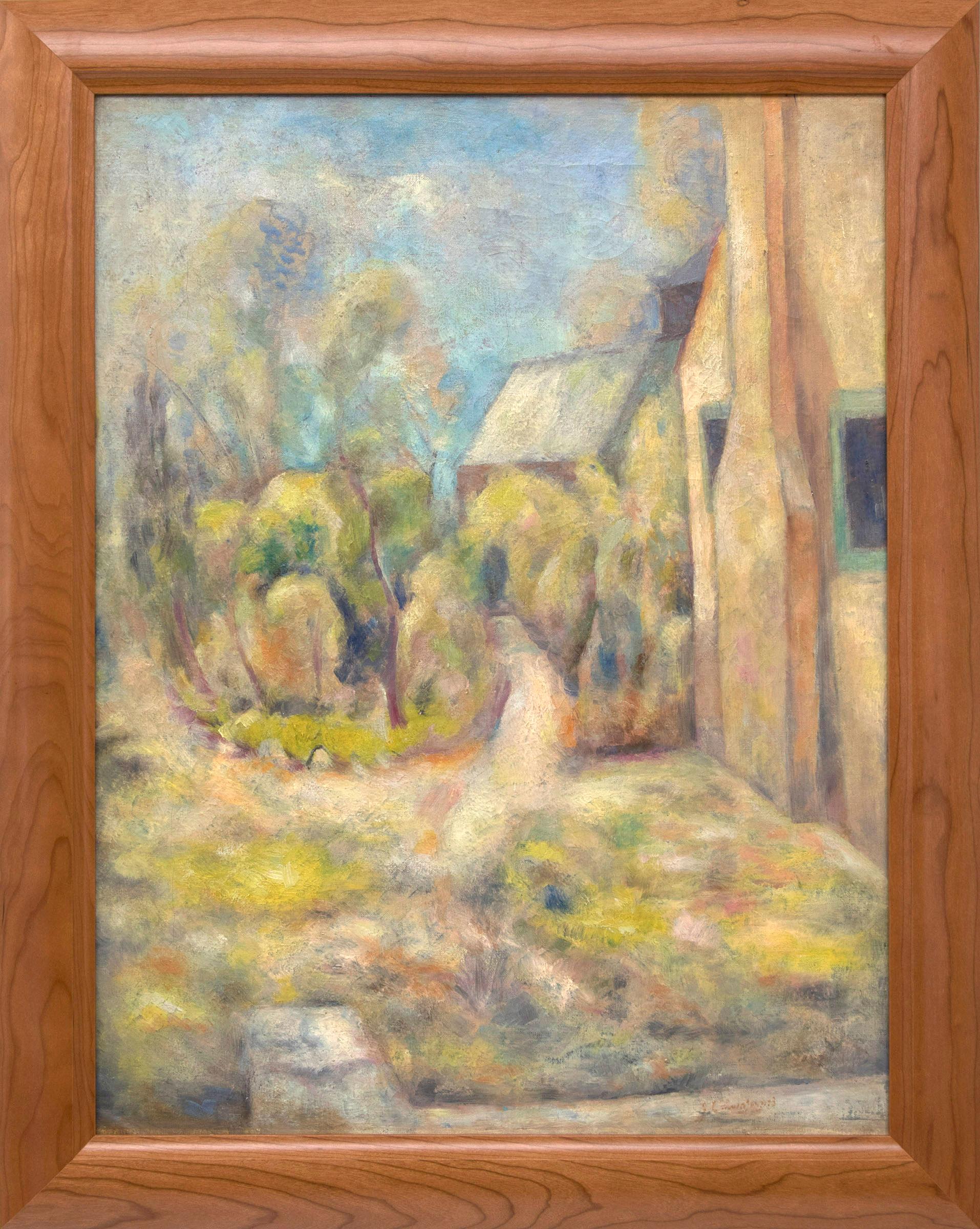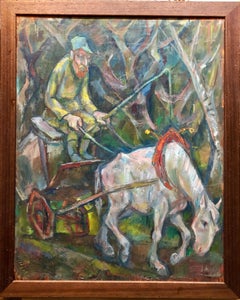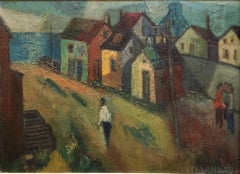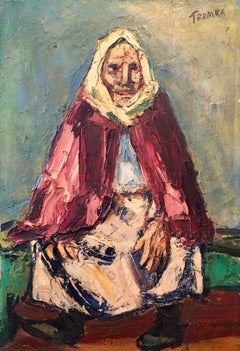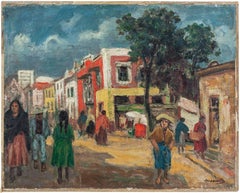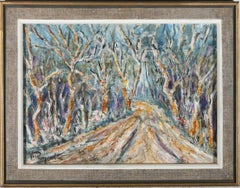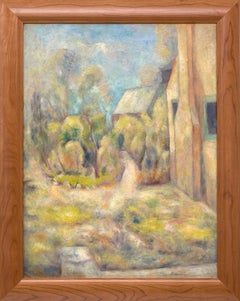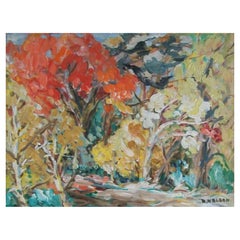Items Similar to LAKEWOOD N.J., 1936 Modernist Oil Painting, Judaica
Want more images or videos?
Request additional images or videos from the seller
1 of 5
Emanuel Glicenstein RomanoLAKEWOOD N.J., 1936 Modernist Oil Painting, Judaica1936
1936
$5,000
£3,762.04
€4,346.34
CA$7,066.31
A$7,672.63
CHF 4,063.22
MX$94,044.51
NOK 50,283.96
SEK 47,515.68
DKK 32,439.32
About the Item
Genre: Modern
Subject: Landscape
Medium: Oil
Surface: Board
Country: United States
Dimensions: 30" x 22"
EMANUEL ROMANO
Rome, Italy, b. 1897, d. 1984
Emanuel Glicenstein Romano was born in Rome, September 23, 1897.
His father Henryk Glicenstein was a sculptor and was living in Rome with his wife Helena (born Hirszenberg) when Emanuel was born. His father obtained Italian citizenship and adopted the name Enrico. Emanuel was brought up in Italy, Switzerland, Germany, England and Poland.
In 1926 Emanuel and his father sailed for New York. They briefly visited Chicago. Romano's sister, Beatrice, and mother only joined them in New York years later.
Romano changed his name on his arrival to America and some have erroneously speculated that this was to avoid antisemitic discrimination. In truth, as the son of a highly-regarded artist, Romano changed his name to ensure that any success or recognition he would later attain, would be the result of nothing other than his own merit as an artist, and not on account of his father's fame.
In 1936 Romano was worked for the Federal Art Project creating murals. During and immediately after World War II, Romano created a series of allegorical works depicting graphic holocaust images that were held closely by the family until after his passing. One of these works is now on permanent display in the Florida Holocaust Museum in St. Petersburg Florida.
Emanuel's father died in 1942 in a car accident before they could realize their shared dream of visiting Israel.
In 1944 Romano, having completed his degree at the Pennsylvania Academy of Fine Arts and the Art Institute of Chicago, began teaching at the City College of New York.
Romano moved to Safed, Israel in 1953 and established an art museum in his father's memory, the Glicentein Museum.
COLLECTIONS
Indianapolis Museum of Art
Metropolitan Museum of Art
Boston Fine Arts Museum
Fogg Museum
Musée Nacional de France
Recently his work has been added to the Florida Holocaust Museum collection. His notable works include his holocaust themed allegorical paintings as well as portraits of Marianne Moore, his father and William Carlos Williams. Romano created a well known portrait of T.S. Eliot as well as the woodcuts to illustrate an edition of Eliot's "The Waste Land".
Emanuel Romano died in 1984.
- Creator:Emanuel Glicenstein Romano (1897 - 1984, American, Italian)
- Creation Year:1936
- Dimensions:Height: 30 in (76.2 cm)Width: 22 in (55.88 cm)
- Medium:
- Movement & Style:
- Period:
- Condition:wear commensurate with age and use. unframed with some edge wear to board.
- Gallery Location:Surfside, FL
- Reference Number:1stDibs: LU38211971592
About the Seller
4.9
Platinum Seller
Premium sellers with a 4.7+ rating and 24-hour response times
Established in 1995
1stDibs seller since 2014
1,807 sales on 1stDibs
Typical response time: 1 hour
- ShippingRetrieving quote...Shipping from: Surfside, FL
- Return Policy
Authenticity Guarantee
In the unlikely event there’s an issue with an item’s authenticity, contact us within 1 year for a full refund. DetailsMoney-Back Guarantee
If your item is not as described, is damaged in transit, or does not arrive, contact us within 7 days for a full refund. Details24-Hour Cancellation
You have a 24-hour grace period in which to reconsider your purchase, with no questions asked.Vetted Professional Sellers
Our world-class sellers must adhere to strict standards for service and quality, maintaining the integrity of our listings.Price-Match Guarantee
If you find that a seller listed the same item for a lower price elsewhere, we’ll match it.Trusted Global Delivery
Our best-in-class carrier network provides specialized shipping options worldwide, including custom delivery.More From This Seller
View AllLarge Modernist Oil Painting 1940s, Judaica Hasidic Shtetl Wagon Driver WPA Era
By Emanuel Glicenstein Romano
Located in Surfside, FL
Genre: Modern
Subject: Landscape with figure of horse, driver and wagon
Medium: Oil
Surface: wood Board
EMANUEL ROMANO
Rome, Italy, b. 1897, d. 1984
Emanuel Glicen Romano was born in Rome, September 23, 1897.
His father Henryk Glicenstein was a sculptor and was living in Rome with his wife Helena (born Hirszenberg) when Emanuel was born. His father obtained Italian citizenship and adopted the name Enrico. Emanuel was brought up in Italy, Switzerland, Germany, England and Poland.
In 1926 Emanuel Glicenstein Romano and his father sailed for New York. They briefly visited Chicago. Romano's sister, Beatrice, and mother only joined them in New York years later.
Romano changed his name on his arrival to America and some have erroneously speculated that this was to avoid antisemitic discrimination. In truth, as the son of a highly-regarded artist, Romano changed his name to ensure that any success or recognition he would later attain, would be the result of nothing other than his own merit as an artist, and not on account of his father's fame.
In 1936 Romano was worked for the WPA Federal Art Project creating murals. ( there were many jewish artists active with in the WPA period. notably Chaim Gross, Ben Shahn, Isaac and Moses Soyer, Abraham Rattner and many others. During and immediately after World War II, Romano created a series of allegorical works depicting graphic holocaust images that were held closely by the family until after his passing. One of these works is now on permanent display in the Florida Holocaust Museum in St. Petersburg Florida.
Emanuel's father died in 1942 in a car accident before they could realize their shared dream of visiting Israel.
In 1944 Romano, having completed his degree at the Pennsylvania Academy of Fine Arts and the Art Institute of Chicago, began teaching at the City College of New York.
Romano moved to Safed, Israel in 1953 and established an art museum in his father's memory, the Glicenstein Museum.
COLLECTIONS
Indianapolis Museum of Art
Metropolitan Museum of Art
Boston Fine Arts Museum
Fogg Museum
Musée Nacional de France
Recently his work has been added to the Florida Holocaust Museum collection. His notable works include his holocaust themed allegorical paintings as well as portraits of Marianne Moore, his father and William Carlos Williams...
Category
1930s American Modern Figurative Paintings
Materials
Oil, Board
WPA Period "Coastal Village" American Modernist Realism Oil Painting Lev Landau
By Samuel David Lev-Landau
Located in Surfside, FL
Signed and titled with Yiddish inscription verso.
9 X 12 inches board size. beng sold unframed.
Painter, New York, N.Y. Samuel David Lev-Landau was born in Warsaw, Poland and emigr...
Category
Mid-20th Century Modern Landscape Paintings
Materials
Oil
Rare Polish American 1930s Oil Painting Painting WPA Russian Babushka Jewish Art
By Abram Tromka
Located in Surfside, FL
Abram Tromka was born May 1, 1896 in Poland. At the age of seven he immigrated with his family to the United States, settling in New York City. It was on the boat coming to New York ...
Category
1930s American Modern Figurative Paintings
Materials
Oil, Board
Street Scene Oil Painting Circa 1930s
By Albert Abramovitz
Located in Surfside, FL
Albert Abramovitz (1879-1963), born in Riga, Latvia, on January 24, 1879. He studied art at the Imperial Art School in Odessa and at the Grande Chaumière in Paris. In Paris, he becam...
Category
Early 20th Century American Impressionist Figurative Paintings
Materials
Canvas, Oil
Rabbi in Jerusalem Modernist Israeli Judaica Oil Painting Arie Alweil Viennese
By Arieh Allweil
Located in Surfside, FL
ARIEH ALLWEIL [ARIE ALWEIL] 1901-1967
Galicia 1901-1967 Safed, Israel (Ukranian/Polish/Israeli)
Arieh Allweil, born 1901, Galicia. Immigrated to Palestine in1920. Studies: 1921-25 Art Academy, Vienna; Dresden Academy. ALlweil brought with him the high values of the Central European avant-garde, which he had absorbed during his years of study in Vienna. He joined the ‘Kunstschau’ group- of artists that had formed around Gustav Klimt and Egon Schiele. He exhibited with them in the 1920’s, and emigrated to Palestine in 1926. He was one of the founders of the Tel Aviv Art Museum and the Midrasha Art Teachers College in Israel. As opposed to other modern Israeli artists in his period, Allweil's woodcuts and illustrations pertained to contemporary events such as the Holocaust and the pioneering spirit before the establishment of the State of Israel. Most notable is this work as well as the first illustrated Passover Haggada for the IDF which he made in 1950 and which was printed for 3 years with his inspirational woodcut illustrations. He published a series of linoleum cuts of Israeli and Biblical subjects and created large scale murals of the Holocaust.
Teaching: In Israel, art. Prizes: Received Dizengoff Prize twice; 1955 Turov Prize for Bible Illustrations. Published series of linoleum cuts of Israeli and Biblical subjects, also illustrated a Passover Haggada and large scale murals of Holocaust. From 1952 until his death lived in Tel Aviv and in Safed in summer. Died 1967, Safed.
Education
1921-25 Art Academy, Vienna, Austria
1921-25 Dresden Academy, Germany
Teaching
Herzliyah Gymnasium High-School, Israel, art.
Tel Aviv High School
Awards And Prizes
1937 Dizengoff Prize for Painting and Sculpture,
Tel Aviv Museum of Art, Municipality of Tel Aviv-Jaffa
1946 Dizengoff Prize
1955 Turov Prize for Bible Illustrations
Select Solo Exhibition:
1933 Tel Aviv Museum, Solo Exhibition
1942 Katz Gallery, Tel Aviv
1950 Tel Aviv Museum, Tel Aviv
1956 The Blue Dome, Safed
1968 Memorial Exhibition of the artist Arieh Allweil Yad Labanim Museum, Petach-Tikva
1969 Solo Exhibition The Knesset, Jerusalem
1987 Arieh Allweil: 1901-1967 - ''Return to Betanya Ilit'' Beit Gabriel, Zemah
1994 Arieh Allweil: Prints and Caligraphy The Isaac Kaplan Old Yishuv Court Museum,Jerusalem
2011 Arieh Allweil, Letters, Figures, Landscapes
Mishkan Le'omanut, Museum of Art, Kibbutz Ein Harod
Select Group Exhibitions
1929 Eged - Palestine Painters Group Allenby Street, Tel Aviv
Artists: ChanaOrloff, Abraham Melnikoff, Reuven Rubin, Nachum Gutman, Sionah Tagger, Arieh Allweil, Haim Gliksberg, Yossef Zaritsky, Leon Arie Fein, Pinchas Litvinovsky, Elias Newman.
1932 The Bezalel National Museum, Jerusalem
Artists:
Litvinovsky, Pinchas Gutman, Nachum Allweil, Arieh
Exhibition of Artists: P. Litvinovsky, A. Allweil, N. Gutman
1936 First Exhibition of ''Hever Omanim'' Steimatzky Galleries, Jerusalem
Artists:
Gutman, Nahum Holzman, Shimshon Moshe Mokady, Miron Sima, Jakob Steinhardt, Zeev Ben Zvi, Moshe Ziffer, Allweil, Arieh.
1944 Collective Annual Exhibition by Palestinian Artists
Art Gallery of the ''Habima'' Building, Tel Aviv
Artists:
Hermann Struck, Hermann Moshe Sternschuss, Arie Reznik, Aaron Priver, Itzhak Danziger, Itzhak Zvi Aldouby, Menahem Shemi...
Category
20th Century Modern Figurative Paintings
Materials
Canvas, Oil
Large Polish Israeli Landscape Mid Century Oil Painting
Located in Surfside, FL
Genre: Modern
Subject: Cityscape
Medium: Oil
Surface: Canvas
Country: Israel
Dimensions: 36 1/4" x 25 3/4" x 3/4"
Dimensions w/Frame: 44 3/4" x 34"
Rare Modern Mid Century Israel landscape...
Category
20th Century Modern Landscape Paintings
Materials
Canvas, Oil
You May Also Like
W. Rogdurski - Mid 20th Century Oil, Droga Do Grabowa
Located in Corsham, GB
This expressive study captures a winding road lined with trees. The artist captures the bare branches of the winter trees in an expressive colour palette and using an impasto techniq...
Category
Mid-20th Century Landscape Paintings
Materials
Oil
$401 Sale Price
20% Off
Early Spring, 1930s Impressionist Style Oil Painting of Artist’s Studio Exterior
By John Edward Thompson
Located in Denver, CO
This original oil on canvas painting, titled Early Spring (Thompson's Studio), was created in 1933 by renowned Colorado modernist John Edward Thompson (1882-1945). A striking example...
Category
1930s American Modern Landscape Paintings
Materials
Canvas, Oil
French Impressionist oil painting Caldwell Woods Chicago Plein Air Original 1940
Located in Buffalo, NY
An original french impressionist plein air painting depicting the Caldwell Woods Nature Preserve in Chicago, IL.
Louis Phillipe Kamm traveled to the US, visiting major cities, and p...
Category
1940s Impressionist Landscape Paintings
Materials
Canvas, Oil
D. Nelson, Expressionist Oil Painting on Panel, Signed, Canada, circa 1950's
Located in Chatham, ON
D. NELSON - 'Untitled' - mid-century Expressionist landscape oil painting on canvas board - signed lower right - Canada - circa 1950's.
Excellent vintage condition - professionall...
Category
Mid-20th Century Canadian Expressionist Paintings
Materials
Canvas, Paint
Important Regionalist WPA Modern Framed And Signed Landscape Oil Painting
By Martyl Suzanne Schweig Langsdorf
Located in Buffalo, NY
Modernist landscape oil painting by Suzanne Schweig Langsdorf Martyl (1917/18 - 2013). Oil on board. Signed. Framed. Measuring 28 by 32 inches overall and 20 by 24 painting alone.
Category
1940s Modern Landscape Paintings
Materials
Canvas, Oil
Rare & Special Painting by Important Chicago Modernist Artist Davenport Griffen
Located in Chicago, IL
A 1936 Modernist landscape painting with figures by important Chicago artist (William) Davenport Griffen. His paintings tend to be rare. Image size: 18" x 20". Framed size: 22" x 24".
(William) Davenport Griffen was born in 1894 in Millbrook, NY. He graduated from Iowa State College in Ames, IA in 1918 with a B.S. in Civil Engineering; however, Griffen’s true love was painting. In 1919, he enrolled in the Chicago Academy of Fine Arts and subsequently studied at the Art Institute of Chicago from 1923-1928. In 1926, he was awarded the American Travel Scholarship and began painting in Provincetown, MA. In 1928, he was awarded the John Quincy Adams Scholarship and spent six months painting in Paris, France. Griffen also painted in the U.S. Virgin Islands for 11 months between 1930-1931. Griffen had one-man exhibitions of his Virgin Islands paintings...
Category
1930s American Modern Landscape Paintings
Materials
Oil, Canvas
